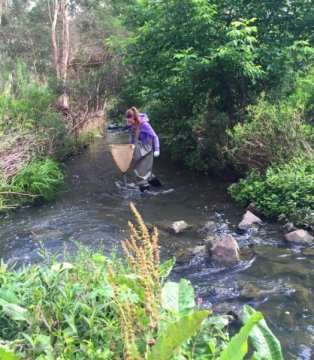[ad_1]
Sixty-nine pharmaceutical compounds have been detected in stream insects, some at concentrations that may threaten animals that feed on them, such as trout and platypus. When these insects emerge as flying adults, they can pass drugs to spiders, birds, bats, and other streamside foragers. These findings by an international team of researchers were published today in Nature Communications.
Pharmaceutical pollution is present in surface waters globally. Drugs enter the environment because most wastewater treatment facilities are not equipped to remove them from sewage. Septic tanks, aging pipes, and sewer overflows contribute to the problem.
Emma Rosi, an aquatic ecologist at Cary Institute of Ecosystem Studies and a coauthor on the paper, explains, “Stream life is swimming in a mixture of pharmaceuticals. Our study is the first to show that this chronic drug pollution can concentrate in aquatic insects and move up food webs, in some cases exposing top predators to therapeutically-relevant doses.”
Surveying pharmaceuticals in streams
The team sampled six streams in Melbourne, Australia for 98 pharmaceutical compounds — the most exhaustive screening to date. Pharmaceuticals measured included common drugs like antibiotics, antidepressants, antihistamines, and NSAIDs. Study sites were selected along a gradient of wastewater contamination that included a site downstream of a wastewater treatment plant and a site in a national park.
Aquatic insects and riparian spiders were collected. Erinn Richmond, a freshwater ecologist at Monash University in Australia and lead author on the study, explains, “We focused on riparian spiders because they build their webs over streams and feed on adult aquatic insects as they emerge from the water.”
Bugs on drugs
Tissue analyses detected up to 69 different pharmaceutical compounds in aquatic insects and up to 66 compounds in riparian spiders. Drug concentrations were the highest in invertebrates collected downstream of wastewater treatment facilities or in heavily populated areas with potential septic tank leakage. On average, pharmaceutical concentrations at these sites were 10 to 100 times higher than less contaminated sites.
Coauthor Jerker Fick, a chemist at Umeå University in Sweden, analyzed the insect and spider samples. “Insect tissues had drug concentrations that were orders of magnitude higher than concentrations measured in surface waters. We also found a diverse suite of drugs in spiders, indicating that drugs are passed from the water to prey to predator, thereby exposing other animals in the food web to drugs.”
“Pharmaceuticals were present in every insect and spider we tested — including those collected in Dandenong Ranges National Park,” Richmond notes. “Even this seemingly pristine site was contaminated, likely because people live in the park’s drainage area and visit the park.”
Top predators are at risk
In the streams studied, platypus and brown trout also feed on aquatic insects. By pairing concentrations of pharmaceuticals found in stream insects with known dietary needs of platypus and trout, the team was able to estimate their drug exposure.
Rosi explains, “A platypus living in a creek receiving treated wastewater effluent could receive the equivalent of half of a recommended human dose of antidepressants every day — just by eating its normal diet of stream insects. This intake is likely to have biological effects.”
Next steps
The caddisfly, a globally common aquatic insect, was among those tested in this study. Richmond says, “Similar insects are found in freshwaters all over the world. This isn’t a problem specific to Australia; it’s representative of what’s likely happening wherever people take drugs. And it’s likely an underestimate. We only tested for 98 pharmaceutical compounds — there are thousands in circulation.”
Rosi concludes, “Pharmaceutical use is increasing worldwide. It’s clear that the drugs we take are entering freshwaters and being passed up the food web. We don’t know the ecological consequences of exposure to this pollution. What does it mean to be a platypus or trout with more than 60 drugs in your tissues? Are there synergistic effects? More research is needed on the extent of food web contamination and the effects of these compounds on fish and wildlife.”
[ad_2]















